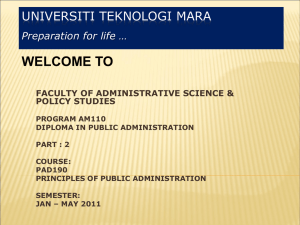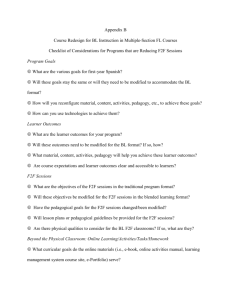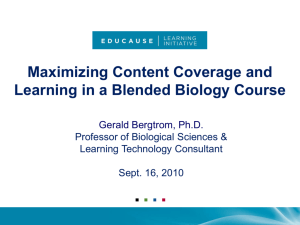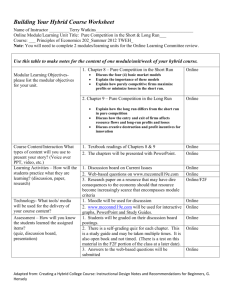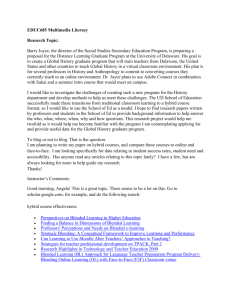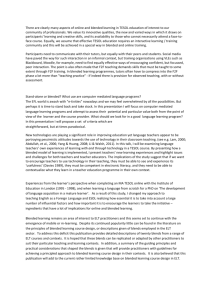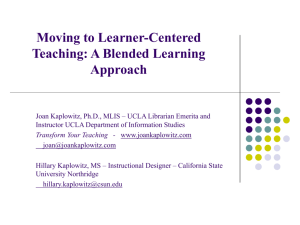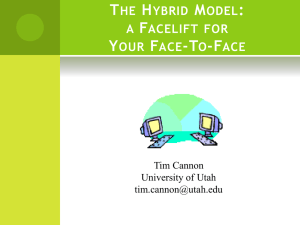Blended Learning Best Practices
advertisement
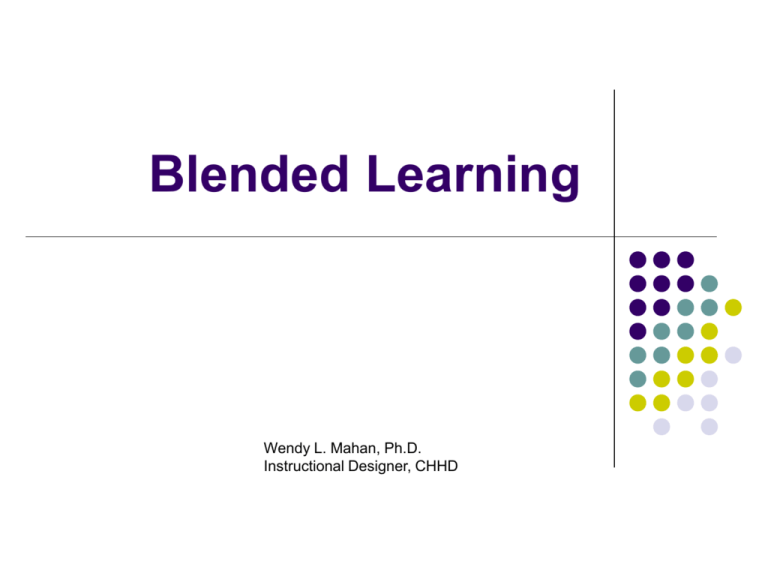
Blended Learning Wendy L. Mahan, Ph.D. Instructional Designer, CHHD My Background Education Technology Services (ETS) Courseware Initiative 2003-2005 Blended Learning Initiative 2005-2007 CHHD/Nursing since Jan 2008 BLI – Quick History General education courses Develop online version and hybrid version. Purpose: Curricular Integrity, efficient use of resources, free up classrooms, student preferences. Assessment completed by SITE. Blended or Hybrid Course HYBRID/ BLENDED F2F Web Enhanced Completely Online Broad Recommendations from the Literature • Redesign - don’t add on elements. • Hold an initial kick-off meeting. • Make students aware of what a hybrid course entails. • Assist with time management skills. • If using teams, do the following: • Use early F2F meetings to establish community, roles and rules. • Decrease these meetings as semester goes on. • Ensure F2F meetings are of *value.* Recommendations based on BLI Experience • Kick off meetings are essential. • Face-to-face meetings must include active participation. • Face-to-face meetings must result in some type of points earned. • Face-to-face meetings must be integrated with online materials, and together, they must keep the student engaged during the week. • Face-to-face meetings provide the opportunity to create better student-instructor interaction than online only. • Developing an online course first, and then developing the hybrid is easier than vice versa. Lessons learned based on BLI Experience •If students find that they are not accountable for face-to-face meetings, attendance will drop – dramatically. •Blended learning decreases class size and increases faculty workload – unless the designed correctly. •If the online activities and face-to-face experience are not seamless and engaging, it is very easy for the student – and the faculty member – to forget about the class. •Before choosing a day for the F2F meeting, decide on the design first. How do you develop blended courses? Table of Comparative Advantage David Brown, VP and Dean of International Center for Computer Enhanced Learning at Wake Forest University. This technique encourages one to place the right activities in their most appropriate environments. Table of Comparative Advantage "What activities that I normally pursue in a traditional classroom can be transitioned online with the least loss in effectiveness?" Activity F2F only Online Notes Lectures Disadvantage Advantage F2F passive; online can be made interactive and more adaptable to individual needs Guest speakers Disadvantage Advantage Difficult to find someone free during class time; student who can’t attend cannot make it up. Small Group discussions Advantage Disadvantage Easier to communicate F2F, but run out of time frequently; could extend to online message boards Table of Comparative Advantage "What activities that I normally pursue online that will increase in effectiveness if I move them back to a F2F format? Activity F2F only Online Notes Online Lessons Disadvantage Advantage Address individual learning needs; always accessible Online Quizzes Disadvantage Advantage Self-scoringlessens workload Periodic Message board Discussions Disadvantage Advantage Can’t do F2F due to large class size and room layout Bullet-Proof Model (Troha, 2002) 1. 2. 3. 4. Conduct a learner & context analysis of your course List your learning objectives. Conduct content analysis - course outline. Identify the learning activities in the outline that would be the *best* in a face-to-face, traditional setting. 5. Identify the learning activities in the outline with the potential for online delivery. 6. Make final decisions about course delivery considering #1-#5: 3-C Didactic Model (Kerres & De Witt, 2003) Evaluation Synthesis Construction Analysis Application Understanding Knowledge Bloom’s Taxonomy Communication Content 3-C Didactic Model (Kerres & De Witt, 2003) 1. 2. 3. List learning objectives. Classify each according to three components. Determine how much of the course will be devoted to each type of component 4. Rule of Thumb: Content, 33%; Communication, 33%; Construction, 33% Mathematics: Content, 30%; Communication, 20%, Construction, 50% Nutrition: Content, 80%; Communication, 5%; Construction, 15% Determine delivery system based on aspects of that particular course. Who is the audience? Is group work involved? What are the costs (time, travel, cognitive demands, etc.) What do these models have in common? Break down your content Identify the delivery method (online vs. F2F). Consider the above in conjunction with targeted audience, context of instruction, available resources, etc. My experienced confirmed… Consistency of who will be teaching semester to semester No. of Students enrolled in course Learning objectives/ content covered Student Motivation Individual characteristics of faculty Faculty workload/Access to TAs Existing format of course Analysis and Design No. of meetings per week Things to consider Taught by TAs High enrollment Lower –level objectives; survey course Low student motivation – required course More research focused; conservative High Workload, no TAs Currently F2F format Online Not enough to do in F2F or all F2F lectures Things to consider Same instructor teaches every semester Low enrollment (<30 students) High student motivation ;major –related course Teaching focused; adventurous Reasonable Workload or access to TAs High level objectives Currently online format Hybrid Variation in meetings lends itself to collaborative projects Example – UNT What technologies can be used to create an ideal blended course? ANGEL Best for: •Online lessons •Posting links to online resources or placing articles on course reserve. •Discussion forums •Quizzes Advantages: In control of content, grading, secure Disadvantages: Storage issues, students view as rigid and constricting Web 2.0 Tools For student-created, collaborative assignments and projects – some examples include: •Google Docs or Zoho •MyPlick •WetPaint •Ning •Gliffy •Toondo Advantages: Encourages collaboration and creativity, low learning curve, free Disadvantages: No control over content, copyright issues, grading PSU Resources Blogs @ Penn State Adobe Connect Digital Commons (student-created podcasts and videos) Advantages: In control of content, secure, tech support Disadvantages: technical glitches, frequent updates to new platforms, tech support, plus scheduling issues with Digital Commons Questions? References Models: Troha, F. J. (2002). Bulletproof instructional design: A model for blended learning. USDLA Journal, 16 (5). Retrieved October 20, 2005 from: http://www.usdla.org/html/journal/MAY02_Issue/article03.html Kerres, M. & DeWitt, C. (2003). A didactic framework for the design of blended learning arrangements. Journal of Educational Media, 28(2-3). Retrieved September 2005 from: http://online-campus.net/edumedia/publications/Draft-JEM-BL.pdf Examples University of North Texas – Blended Learning Project: http://web3.unt.edu/cdl/BLP/index.cfm?M=Courses Web 2.0 Tools Google Docs: http://docs.google.com Zoho: http://www.zoho.com/ MyPlick: http://www.myplick.com/ Ning: http://www.ning.com/ Gliffy: http://www.gliffy.com/ Toondo: http://www.toondoo.com/ PSU Resources Blogs at Penn State: http://blogs.psu.edu/ Adobe Connect: http://meeting.psu.edu/forum Digital Commons: http://digitalcommons.psu.edu/
